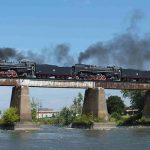It was stated to in 1867 that the building of the Brooklyn Bridge would create not only the greatest bridge at that time, but also the greatest example of engineering of that age on the continent! For the tourists of today, a stroll down under the Brooklyn Bridge to a restaurant is on their agenda.
Introducing the Brooklyn Bridge

The Brooklyn Bridge has been sometimes called the Eighth Wonder of the World and was recognized as possibly the greatest feat of engineering during the nineteenth century. This was contributed to by the fact that whilst many bridges were constructed in that century, conversely many collapsed. This generally occurred either within a few decades or sometimes within a few years.
A decision was taken for the building of the Brooklyn Bridge, primarily for the provision of faster and convenient commuting between Brooklyn and Manhattan, the financial center of New York City. The journey by automobile and the ferry service operating at that time, was both costly and time consuming.
The Initial Design of John Roebling – And Some Problems

It was in 1869 that the New York Bridge Company was formed by John Roebling and his design for the bridge accepted. However, discussions concerning the construction of the bridge and the financial, technical and political aspects, took place over a period of about sixty years. During the early stages of construction, John Roebling was involved in an accident, the result of which caused his death. Washington Roebling his son replaced him as chief engineer and remained in various capacities with the project until bridge construction was completed.
The Structure and the Caissons
Caissons were an integral part of the construction for the towers in the building of the Brooklyn Bridge. They had the appearance of large, wooden boxes open at the bottom. After being towed into position, they were then sunk to the river bed; workers were placed inside, for the purpose of digging mud and debris from the river bed. To prevent the caissons flooding, compressed air was pumped in.
The stone towers were constructed on top of the caissons and as the work progressed, the workers inside, named “sandhogs” dug deeper. Upon reaching bedrock, the digging ceased and the caissons were then filled with concrete. The
foundations for the bridge were thus formed. Today, the Brooklyn caisson lies forty four feet beneath the surface of the water. It was necessary to settle the Manhattan caisson deeper and this lies seventy eight feet beneath the surface.
The Brooklyn Bridge is the longest suspension bridge of its era and when built, was the highest free standing structure of the Northern hemisphere. With a span of over six thousand feet, on ramps included, the bridge incorporates ropes made from steel, which were manufactured six times stronger than required for supports.
Workers lives were lost during the building of the Brooklyn Bridge. Whilst no official records were maintained, a booklet compiled by the Master Mechanic named Farrington and supported by Chief Engineer William Kingsley, stated that twenty men died. This again is supported by newspaper reports and on occasions in minutes of the Bridge Company meetings.
A bridge of “Firsts:” The Brooklyn Bridge was the original suspension bridge to utilize steel for the cable wire and the usage of pneumatic caissons. Another dangerous first is the use of explosives within the confines of a caisson. It is also recorded that at the time of completion, this 3460 feet in length suspension bridge was the longest of its kind in the world, being fifty percent longer than any other suspension bridge!

A bridge of “Height:” The towers loom 276½ feet above the water at high tide. As a comparison in 1883, the spire of Trinity church was 281 feet. From the roadway, the towers reach a height of 159 feet and the tower arches 117 feet. The height of the roadbed from the water is 135 feet.
Bridge Calamities: during the building of the Brooklyn Bridge those included the death of John A. Roebling and the illness and disablement of his son, Washington. Other occurrences that took place were a caisson fire, an explosion, and the discovery of fraud on the part of a contractor.
The Brooklyn Bridge opened – May 24, 1883, 2:00 pm. On that day, the Irish workers demonstrated with a protest against “Opening Day” coinciding with the birthday of Queen Victoria of England.



Comments are closed